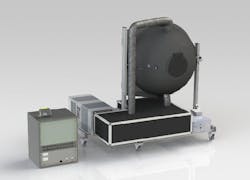North Syracuse, NY–An environmental control unit (ECU) is being designed and built by Air Innovations for a light-emitting diode (LED) metrology system being developed by a photonics customer. The system consists of a 40-inch-diameter aluminum integrating sphere coated on the inside with highly reflective material that is used in conjunction with a spectrometer to measure the brightness and quality of light from LED bulbs. The ECU improves the measurement quality of the system.
One technical challenge that LED manufacturers must address before achieving that market share is that, unlike other light sources, LED performance is greatly influenced by the temperature of the device where it is used. As the temperature varies, the light output will vary as well, causing not only a change in the total optical power, but a shift in the color. High usage of an LED in high ambient temperatures may result in overheating and a shortening of the usable life of the device. Therefore, the temperature-controlled test environment provides a means for LED and luminaire manufactures to evaluate the entire performance envelope of their devices prior to installing them in the field.
For that reason, the prototype needed an ECU that could provide a constant temperature to the aluminum sphere and reached out to Air Innovations, which derived the prototype's ECU from its existing wine cellar cooling system platform, customizing the controls to meet the manufacturer's needs. To perform tests at a wide range of temperatures, the ECU generates 300-400 cubic feet of air per minute, ranging from 5° to 50° Celsius (41° to 122° Fahrenheit) in the sphere.
The temperature-controlled air is blown through the sphere to maintain a constant temperature. Through computer control, the air is diverted for the few seconds while the test is conducted, thus minimizing air flow around the device that might change the heat transfer from the device to the ambient environment and ensuring reliable results. At the moment the test is completed, air is restored to the sphere to maintain the desired temperature. The ECU is integrated with the sphere system with special controls, allowing it to communicate with external equipment and monitor performance.
The system is being developed to meet the demands of formalized worldwide standards IESNA LM-79 and LM-82 to consistently measure the light output of LEDs. These standards will become even more critical in future years as LED demand continues to expand. A recent University of Chicago study, for example, says that LEDs will capture 60 percent of the global lighting market over the next decade.
Air Innovations designs and manufactures specialty temperature, humidity, filtration and pressure control solutions for process applications across a range of industries, including aerospace, cleanroom, pharmaceutical, photonics, semiconductors, and more.
SOURCE: Air Innovations; www.airinnovations.com

